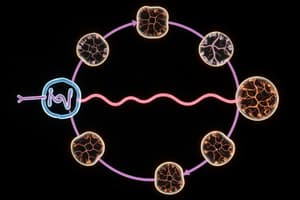Podcast
Questions and Answers
What is a potential benefit of having a barrier that separates the inside of a cell from its environment?
What is a potential benefit of having a barrier that separates the inside of a cell from its environment?
How does interaction among monomers contribute to cellular processes?
How does interaction among monomers contribute to cellular processes?
What role do high local concentrations of molecules play in cellular architecture?
What role do high local concentrations of molecules play in cellular architecture?
What is a characteristic of nucleic acids in the context of the RNA world?
What is a characteristic of nucleic acids in the context of the RNA world?
Signup and view all the answers
What role do functional groups play in biopolymers?
What role do functional groups play in biopolymers?
Signup and view all the answers
In the context of cellular architecture, what does protection from the environment entail?
In the context of cellular architecture, what does protection from the environment entail?
Signup and view all the answers
What is the significance of self-complementarity in molecular structures?
What is the significance of self-complementarity in molecular structures?
Signup and view all the answers
What happens to a protein if it unfolds in the presence of more monomers?
What happens to a protein if it unfolds in the presence of more monomers?
Signup and view all the answers
What is expected to happen when a biopolymer unfolds in the presence of monomers?
What is expected to happen when a biopolymer unfolds in the presence of monomers?
Signup and view all the answers
What is a significant factor that contributes to cellular function according to the RNA world hypothesis?
What is a significant factor that contributes to cellular function according to the RNA world hypothesis?
Signup and view all the answers
How does natural selection interact with cellular architecture?
How does natural selection interact with cellular architecture?
Signup and view all the answers
What type of reactions are primarily involved in forming biopolymers?
What type of reactions are primarily involved in forming biopolymers?
Signup and view all the answers
How do nucleophiles and electrophiles differ in chemical reactivity?
How do nucleophiles and electrophiles differ in chemical reactivity?
Signup and view all the answers
What best describes the relationship between interaction and internal structure in biopolymers?
What best describes the relationship between interaction and internal structure in biopolymers?
Signup and view all the answers
What does the unfolding of biopolymers indicate in terms of their chemistry?
What does the unfolding of biopolymers indicate in terms of their chemistry?
Signup and view all the answers
What happens during a condensation reaction involving monomers?
What happens during a condensation reaction involving monomers?
Signup and view all the answers
What was the primary outcome of the 1953 Miller & Urey experiment?
What was the primary outcome of the 1953 Miller & Urey experiment?
Signup and view all the answers
Which component was crucial for the success of the Miller & Urey experiment?
Which component was crucial for the success of the Miller & Urey experiment?
Signup and view all the answers
What alternative hypothesis involves underwater geological formations?
What alternative hypothesis involves underwater geological formations?
Signup and view all the answers
What elements predominantly compose organic matter?
What elements predominantly compose organic matter?
Signup and view all the answers
What remains an active area of research related to the origin of organic compounds?
What remains an active area of research related to the origin of organic compounds?
Signup and view all the answers
Which of the following is NOT a proposed source for organic molecules?
Which of the following is NOT a proposed source for organic molecules?
Signup and view all the answers
Which functional groups are characteristic of organic molecules?
Which functional groups are characteristic of organic molecules?
Signup and view all the answers
What underlying premise is shared by the various hypotheses regarding the origin of organic molecules?
What underlying premise is shared by the various hypotheses regarding the origin of organic molecules?
Signup and view all the answers
What role does genetic diversity play in evolution?
What role does genetic diversity play in evolution?
Signup and view all the answers
What is a common misconception about evolution's direction or intent?
What is a common misconception about evolution's direction or intent?
Signup and view all the answers
How do past evolutionary processes influence current organisms?
How do past evolutionary processes influence current organisms?
Signup and view all the answers
What is a consequence of low genetic diversity in a population?
What is a consequence of low genetic diversity in a population?
Signup and view all the answers
Which of the following statements about evolution is true?
Which of the following statements about evolution is true?
Signup and view all the answers
What is meant by the phrase 'more fit individuals' in the context of evolution?
What is meant by the phrase 'more fit individuals' in the context of evolution?
Signup and view all the answers
Which concept does not align with the principles of evolution?
Which concept does not align with the principles of evolution?
Signup and view all the answers
What does genetic variation contribute to within a population?
What does genetic variation contribute to within a population?
Signup and view all the answers
What is the primary focus of the section on biomolecules in the course overview?
What is the primary focus of the section on biomolecules in the course overview?
Signup and view all the answers
Which biomolecule is primarily involved in the storage and transmission of genetic information?
Which biomolecule is primarily involved in the storage and transmission of genetic information?
Signup and view all the answers
What role do proteins play according to the course content?
What role do proteins play according to the course content?
Signup and view all the answers
What key concept is highlighted as a foundational aspect of the course?
What key concept is highlighted as a foundational aspect of the course?
Signup and view all the answers
What is a significant function of carbohydrates in biological systems?
What is a significant function of carbohydrates in biological systems?
Signup and view all the answers
In the context of protein structure, what does folding refer to?
In the context of protein structure, what does folding refer to?
Signup and view all the answers
Which statement is true regarding lipids as discussed in the course overview?
Which statement is true regarding lipids as discussed in the course overview?
Signup and view all the answers
What aspect of water is emphasized in the course content?
What aspect of water is emphasized in the course content?
Signup and view all the answers
Which biomolecules interact to facilitate cellular transport processes?
Which biomolecules interact to facilitate cellular transport processes?
Signup and view all the answers
Which of the following best describes thermodynamics in the context of biology?
Which of the following best describes thermodynamics in the context of biology?
Signup and view all the answers
Study Notes
Biochemistry I (CHM 4621)
- Course instructor: Dan Kraut, Ph.D.
- Date of lecture: 8/26/24
Introductions
- Instructor's background:
- Undergraduate degree in biochemistry from Swarthmore College.
- PhD in biochemistry from Stanford University, focusing on enzyme mechanisms.
- Postdoctoral research at Northwestern University, studying the proteasome and teaching biochemistry.
- Currently teaching the Biochemistry I course at Villanova University for 13 years.
- Instructor's emphasis:
- Teaching is an ongoing process, and student feedback is valued.
- Classroom environment is interactive, encouraging questions and discussion.
- Student expectations:
- Attendance is required.
- Students should review material beforehand and actively participate in class discussions and group activities.
- Quizzes are challenging — an 80% or less score could still result in an A.
- Provide feedback on what is understood and not understood from the material taught.
- Optional problem sessions are offered on Fridays at 12:50.
Evaluation/Grading
- Quizzes (60%):
- Occurring approximately every chapter, lasting 20 minutes.
- Focused on material covered since the previous quiz.
- Include a topic/chapter review.
- Top two lowest quiz scores are dropped.
- Quizzes are expected to be challenging (80% or below can still earn an A).
- In-class/at-home group assignments contribute to quiz grades.
- Homework (12.5%):
- Achieve assignments, completed via the online course platform before each quiz.
- Clickers (7.5%):
- Active participation is necessary and graded based on participation rate.
- Final Exam (20%):
- A cumulative exam resembling a comprehensive quiz.
Historical Grade Distributions
- Historical grade distribution data was presented in a bar graph, showing percentages of students receiving each letter grade (not including the curve adjustment) in Biochemistry 1 from 2018-2023.
Course Learning Objectives
- Gain knowledge of the four major macromolecules in cells (proteins, nucleic acids, lipids and carbohydrates).
- Understand the connection between the structure and function of macromolecules, including dynamics and conformational changes.
- Understand the chemical principles of biological reactions.
- Understand that biochemical reactions obey thermodynamic principles and move toward particular equilibrium states. Enzymatic activity affects reaction rates but not the fundamental driving forces.
- Learn the principles and tools of Biochemistry/Molecular Biology utilized by scientists.
Course Overview
- Topics covered:
- Introduction
- Origin and evolution of cellular architecture
- Thermodynamics
- Water properties
- Biomolecules, including nucleic acids and the structure, and function of amino acids and proteins.
- Protein structure and folding
- Protein function
- Carbohydrates
- Lipids and membranes
- Course sequence emphasis was given.
Today's Learning Objectives (Page 45)
- Summarize early chemical evolution.
- Understand the role of complementarity and self-replication.
- Explain the advantage of compartmentalization.
- Understand endosymbiotic theory for understanding the evolution of cell types.
- Differentiate and understand the three domains of life.
- Understand evolution's role in the present day.
- Explain how past evolutionary changes constrain future evolution.
Origin of Biomolecules
- Early atmosphere: reducing, composed of small simple molecules such as H2O, N2, CO2, CH4, NH3, H2S.
- Potential energy source: lightning
- Result: simple organic molecules (e.g., amino acids) formation.
- Miller-Urey experiment demonstrated this formation.
Biopolymers Formed by Condensation
- Synthesis of polymers (e.g., proteins, polysaccharides, nucleic acids) from monomers (e.g., amino acids, sugars, nucleotides) involves condensation reactions.
Functional Groups Allow Interaction
- Functional groups on biomolecules enable molecule interactions.
Evolution
- Evolution occurs continuously in response to environmental pressures.
- Genetic diversity is crucial for adaptation.
- Evolution is not goal-oriented.
Studying That Suits You
Use AI to generate personalized quizzes and flashcards to suit your learning preferences.
Related Documents
Description
This quiz covers the introductory lecture for Biochemistry I (CHM 4621) taught by Dr. Dan Kraut. Students learn about the instructor's background, teaching philosophy, and course expectations. Engage with the interactive classroom environment and understand assessment criteria to succeed in the course.




